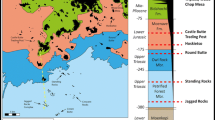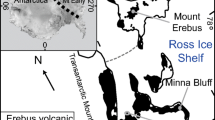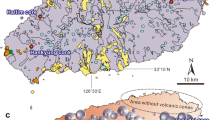Abstract
The island of Nisyros (Aegean Sea) consists of a silicic volcanic sequence upon a base of mafic-andesitic hyaloclastites, lava flows, and breccias. We distinguish two young silicic eruptive cycles each consisting of an explosive phase followed by effusions, and an older silicic complex with major pyroclastic deposits. The caldera that formed after the last plinian eruption is partially filled with dacitic domes. Each of the two youngest plinian pumice falls has an approximate DRE volume of 2–3 km3 and calculated eruption column heights of about 15–20 km. The youngest pumice unit is a fall-surge-flow-surge sequence. Laterally transitional fall and surge facies, as well as distinct polymodal grainsize distributions in the basal fall layer, indicate coeval deposition from a maintained plume and surges. Planar-bedded pumice units on top of the fall layer were deposited from high-energy, dry-steam propelled surges and grade laterally into cross-bedded, finegrained surge deposits. The change from a fall-to a surge/flow-dominated depositional regime coincided with a trend from low-temperature argillitic lithics to high-temperature, epidote-and diopside-bearing lithic clasts, indicating the break-up of a high-temperature geothermal reservoir after the plinian phase. The transition from a maintained plume to a surge/ash flow depositional regime occurred most likely during break-up of the high-temperature geothermal reservoir during chaotic caldera collapse. The upper surge units were possibly erupted through the newly formed ringfracture.
Similar content being viewed by others
References
Bacon CR (1985) Implications of silicic vent patterns for the presence of large crustal magma chambers. J Geophys Res 90:11243–11252
Barberi F, Navarro JM, Rosi M, Santacroce R, Sbrana A (1988) Explosive interaction of magma with ground water: insights from xenoliths and geothermal drillings. Rendiconti Soc Ital Min Petrol 43:901–926
Bohla M, Keller J (1987) Petrology of plinian eruptions of Nisyros volcano, Hellenic Arc. Terra Cognita 7:171
Bond A, (1976) Multiple sources of pumice in the Aegean. Nature 259:194–195
Bond A, Sparks RSJ (1976) The minoan eruption of Santorini, Greece. J Geol Soc London 132:1–16
Brazier S, Sparks RSJ, Carey SN, Sigurdsson H, Westgate JA (1983) Bimodal grain size distribution and secondary thickening in air-fall ash layers. Nature 301:115–119
Carey SN, Sparks RSJ (1986) Quantitative models of the fallout and dispersal of tephra from volcanic eruption columns. Bull Volcanol 48:109–125
Carey SN, Sigurdsson H (1989) The intensity of Plinian eruptions. Bull Volcanol 51:28–40
Carey SN, Sigurdsson H, Sparks RSJ (1988) Experimental studies of particle-laden plumes. J Geophys Res 93:15314–15328
Davis E (1967) Zur Geologie und Petrologie der Inseln Nisyros und Jali (Dodecanes). Praktika Akad Athen 42:235–252
DiPaola GM (1974) Volcanology and petrology of Nisyros Island (Dodecanese, Greece). Bull Volcanol 38:944–987
Druitt TH (1985) Vent evolution and lag breccia formation during the Cape Riva eruption of Santorini, Greece. J Geol 93:439–454
Druitt TH, Sparks RSJ (1987) On the formation of calderas during ignimbrite eruptions. Nature 310:679–681
Druitt TH, Mellors RA, Pyle M, Sparks RSJ (1990) Explosive volcanism on Santorini, Greece. Geol Magazine 126:95–126
Elders WA, Hoagland JR, Williams AE (1980) Hydrothermal alteration as an indicator of temperature and flow regime in the Cerro Prieto geothermal field of Baja California. Geotherm Res Council Transact 4:121–124
Federman AN, Carey SN (1980) Electron microprobe correlation of tephra layers from Eastern Mediterranean abyssal sediments and the Island of Santorini. Quat Res 13:160–171
Fisher RV, (1979) Models for pyroclastic surges and pyroclastic flows. J Volcanol Geotherm Res 6:305–318
Fisher RV, Heiken G (1982) Mt Pelée, Martinique: May 8 and 20, 1902 pyroclastic flows and surges. J Volcanol Geotherm Res 13:339–371
Fisher RV, Schmincke HU (1984) Pyroclastic rocks. Springer, Berlin Heidelberg New York, p 472
Fytikas M, Giuliani O, Innocenti F, Marinelli G, Mazzuoli R (1976) Geochronological data on recent magmatism of the Aegean Sea. Tectonophysics 31: T29-T34
Houghton BF, Schmincke H-U, (1989) Rothenberg scoria cone, East Eifel: a complex Strombolian and phreatomagmatic volcano. Bull Volcanol 52:28–48
Keller J (1971) The major volcanic events in recent eastern Mediterranean volcanism and their bearing on the problem of Santorini ash layers. In: Doumas C (ed) Thera and the Aegean world II, pp 152–169
Keller J (1980) Prehistoric pumice tephra on Aegean Islands. In: Doumas C (ed) Thera and the Aegean world II, pp 49–56
Keller J (1982) Mediterranean island arcs: In: Thorpe RS (ed) Andesites. Wiley, New York, pp 307–325
Keller J, Ryan WBF, Ninkovich D, Altherr R (1978) Explosive volcanic activity in the Mediterranean over the past 200,000 yr as recorded in deep-sea sediments. Bull Geol Soc Amer 89:591–604
Keller J, Gillot PY, Rehren Th, Stadlbauer E (1989) Chronostratigraphic data for the volcanism in the eastern Hellenic arc: Nisyros and Kos. Terra abstracts 1: 354
Limburg E (1986) Young pyroclastics on Nisyros, Greece: physical studies. BA thesis, Wesleyan University, Middletown, CT, USA, pp 119
Limburg E, Lodise L, Varekamp JC (1986) Volcanology and petrology of Nisyros, Greece. In: Sigurdsson H (ed) Environmental impact of volcanism, Norman Watkins Symposium, University of Rhode Island, pp 47–49
Lodise L (1987) Petrology and geochemistry of Nisyros volcano (Dodecanese, Greece). MS Thesis, Wesleyan University, Middletown, CT, USA, pp 245
Martelli A (1917) II gruppo eruttivo di Nisiro nel mare Egeo. Mem Mat. Fis. di Soc Ital Sc (detta dei XL) Serie 3a, Tome XX:79–167
Pyle DM (1989) The thickness, volume and grainsize of tephra fall deposits. Bull Volcanol 51:1–15
Rowley P, MacLeod NS, Kuntz MA, Kaplan AM (1985) Proximal bedded deposits related to pyroclastic flows of May 18, 1980, Mount St. Helens, Washington. Bull Geol Soc Amer 96:1373–1383
Seymour K St, Vlassopoulos D (1989) The potential for future explosive volcanism associated with dome growth at Nisyros, Aegean Volcanic Arc, Greece. J Volcanol Geoth Res 37:351–364
Sheridan MF, Marshall JP (1983) Interpretation of pyroclast surface features using SEM images. J Volcanol Geotherm Res 16:153–159
Sparks RSJ (1986) The dimensions and dynamics of volcanic eruption columns. Bull Volc 48:3–15
Sparks RSJ, Self S, Walker GPL (1973) Products of ignimbrite eruptions. Geology 1:115–118
Sparks RSJ, Wilson L (1976) A model for the formation of ignimbrite by gravitational column collapse. J Geol Soc Lond 132:441–451
Sparks RSJ, Wilson L, Hulme G (1978) Theoretical modeling of the generation, movement, and emplacement of pyroclastic flows by column collapse. J Geophys Res 83:1727–1739
Vinci A (1983) A new ash layer “Nisyros layer” in the Aegean sea sediments. Boll Oceanol Teor Applic 1:341–342
Vinci A (1985) Distribution and chemical composition of tephra layers from Eastern Mediterranean abyssal sediments. Mar Geol 64:143–155
Vroon PZ (1986) Volcanological field studies on the P-1 fall deposit, the older pyroclastic sequence and the domes of Nisyros (Dodecanese, Greece). Unpub field report, University of Utrecht, The Netherlands, pp 53
Wagner GA, Storzer D, Keller J (1976) Spaltspurendatierung quartärer Gesteinsgläser aus dem Mittelmeerraum. N Jb Mineral 1976:84–94
Walker GPL (1973) Explosive volcanic eruptions—a new classification scheme. Geol Rundsch 62:431–446
Walker GPL (1980) The Taupo pumice: product of the most powerufl known (ultraplinian) eruption? J Volcanol Geotherm Res 8:69–94
Walker GPL (1983) Ignimbrite types and ignimbrite problems. J Volcanol Geotherm Res 17:65–88
Walker GPL, McBroom L (1983) Mount St. Helens 1980 and Mount Pelée 1902—Flow or surge?. Geology 11:575–577
Walker GPL, Wilson L, Bowell ELG (1971) Explosive volcanic eruptions—I. The rate of fall of pyroclasts. Geophys J R Astr Soc 22:377–383
Whitham AG, Sparks RSJ (1986) Pumice. Bull Volc 48:209–224
Wilson CJN, Walker GPL (1982) Ignimbrite depositional facies: the anatomy of a pyroclastic flow. J Geol Soc London 139:581–592
Wilson L, Sparks RSJ, Huang TC, Watkins ND (1978) The control of volcanic column heights by eruption energetics and dynamics. J Volcanol Geotherm Res 83:1829–1836
Wilson L, Sparks RSJ, Walker GPL (1980) Explosive volcanic eruptions—IV. The control of magma properties and conduit geometry on eruption column behaviour. Geophys J R Astr Soc 63:117–148
Wohletz KH (1983) Mechanisms of hydrovolcanic pyroclast formation: grain-size, scanning electron microscopy, and experimental studies. J Volcanol Geotherm Res 17:31–63
Wohletz KH, Sheridan MF (1979) A model of pyroclastic surge. Geol Soc Am Spec Pap 180, pp 177–194
Wright JV, Smith AL, Self S (1980) A working terminology of pyroclastic deposits. J Volcanol Geotherm Res 8:315–336
Wright JV, Walker GPL (1977) The ignimbrite source problem: Significance of co-ignimbrite lag-fall deposit. Geology 5:729–732
Wright JV, Walker GPL (1981) Eruption, transport, and deposition of ignimbrite: a case study from Mexico. J Volcanol Geotherm Res 9:111–131
Wyers GP, Barton M (1989) Polybaric evolution of calc-alkaline magmas from Nisyros, Southeastern Hellenic arc, Greece. J Petrol 30:1–37
Author information
Authors and Affiliations
Rights and permissions
About this article
Cite this article
Limburg, E.M., Varekamp, J.C. Young pumice deposits on Nisyros, Greece. Bull Volcanol 54, 68–77 (1991). https://doi.org/10.1007/BF00278207
Received:
Accepted:
Issue Date:
DOI: https://doi.org/10.1007/BF00278207




